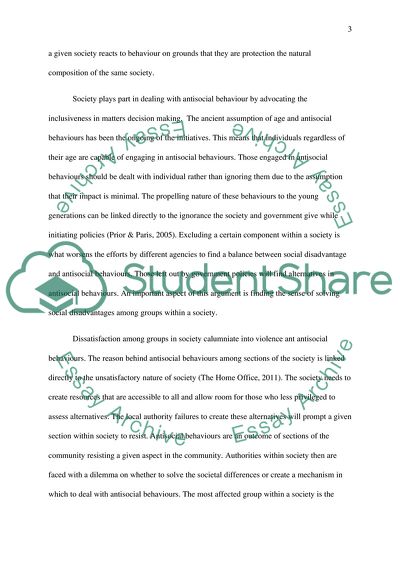Cite this document
(Antisocial Behaviours vs Invisible Socially Disadvantaged Literature review Example | Topics and Well Written Essays - 3250 words, n.d.)
Antisocial Behaviours vs Invisible Socially Disadvantaged Literature review Example | Topics and Well Written Essays - 3250 words. https://studentshare.org/social-science/1854157-local-authorities-should-be-aware-that-a-balance-should-be-struck-between-the-policing-of-anti-social-behaviour-and-the-marginalisation-of-invisible-socially-disadvantaged-groups-do-you-agree-give-reasons-for-your-answer-with-reference-to-initi
Antisocial Behaviours vs Invisible Socially Disadvantaged Literature review Example | Topics and Well Written Essays - 3250 words. https://studentshare.org/social-science/1854157-local-authorities-should-be-aware-that-a-balance-should-be-struck-between-the-policing-of-anti-social-behaviour-and-the-marginalisation-of-invisible-socially-disadvantaged-groups-do-you-agree-give-reasons-for-your-answer-with-reference-to-initi
(Antisocial Behaviours Vs Invisible Socially Disadvantaged Literature Review Example | Topics and Well Written Essays - 3250 Words)
Antisocial Behaviours Vs Invisible Socially Disadvantaged Literature Review Example | Topics and Well Written Essays - 3250 Words. https://studentshare.org/social-science/1854157-local-authorities-should-be-aware-that-a-balance-should-be-struck-between-the-policing-of-anti-social-behaviour-and-the-marginalisation-of-invisible-socially-disadvantaged-groups-do-you-agree-give-reasons-for-your-answer-with-reference-to-initi.
Antisocial Behaviours Vs Invisible Socially Disadvantaged Literature Review Example | Topics and Well Written Essays - 3250 Words. https://studentshare.org/social-science/1854157-local-authorities-should-be-aware-that-a-balance-should-be-struck-between-the-policing-of-anti-social-behaviour-and-the-marginalisation-of-invisible-socially-disadvantaged-groups-do-you-agree-give-reasons-for-your-answer-with-reference-to-initi.
“Antisocial Behaviours Vs Invisible Socially Disadvantaged Literature Review Example | Topics and Well Written Essays - 3250 Words”. https://studentshare.org/social-science/1854157-local-authorities-should-be-aware-that-a-balance-should-be-struck-between-the-policing-of-anti-social-behaviour-and-the-marginalisation-of-invisible-socially-disadvantaged-groups-do-you-agree-give-reasons-for-your-answer-with-reference-to-initi.


